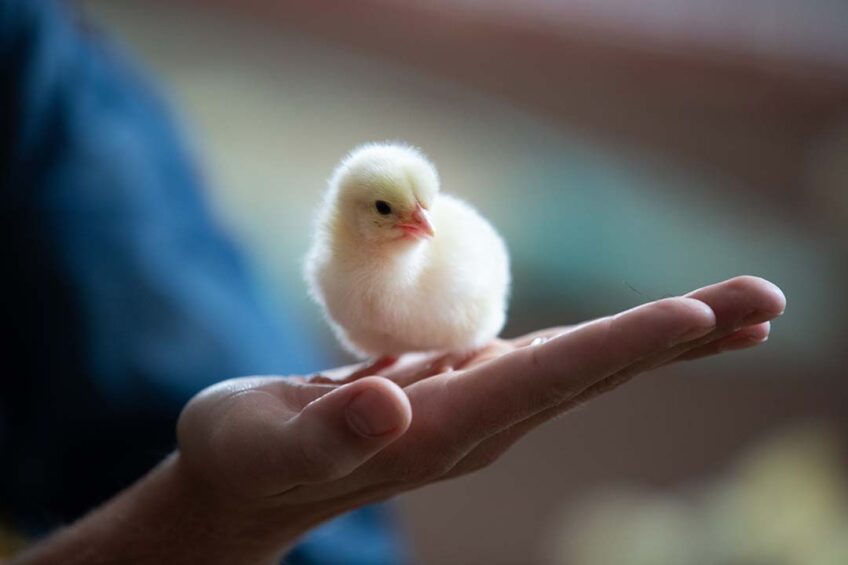Towards sustainability with synthetic microbiota in poultry

Microbiota engineering has demonstrated success in the treatment of disease and improving poultry industry productivity. Microbiota engineering is carried out using feed enzymes, prebiotics and probiotics to alter microbiota composition. Applying a synthetic microbiota is an interdisciplinary activity that requires cooperation between experts in microbiology, animal science, computational biology and engineering science.
Poultry meat and eggs are among the most common sources of animal protein for human consumption worldwide. Antibiotics have also been used heavily for growth-promotion purposes which has resulted in antibiotic resistance in animals, humans and ecosystems. Research studies have suggested that the growth-promoting effects of antibiotics are due to their influence on poultry gut microbiota composition, reducing gut defence, thus enabling the birds to reach their genetic potential. Therefore, to address public health concerns and meet the growing global demand for poultry products, poultry gut microbiota needs to be improved.
Gut microbiota
The gut compartments of poultry are densely populated with complex microbial communities, including bacteria, fungi, Archaea, protozoa and viruses. The interactions between host and gut microbiota play an important role in bird nutrition, physiology and gut development. Gut microbiota reduce the risk of pathogenic bacteria colonisation by creating a protective barrier on the epithelial walls of the enterocyte. Gut microbiota further stimulate the development of the immune system, including the mucus layer, epithelial monolayer and gut immune cells.
Moreover, gut microbiota produce energy and nutrients for the host, such as vitamins, amino acids and short chain fatty acids, from the undigested feed. Gut microbiota also contribute to the metabolism of host nitrogenous compounds and convert uric acid to ammonia which is used to produce amino acids, such as glutamine.
Luminal vs mucosal microbiota
The gut microbiota is divided into luminal microbiota and mucosal microbiota. The composition of the luminal microbiota is affected by the available nutrients, antimicrobial substances and the feed passage rate. The makeup of the mucosal microbiota is determined by the expression of specific adhesion sites on the enterocyte membrane, the secretion of secretory immunoglobulins and mucus production rate. Poultry diet changes both luminal and mucosal microbiota and impact gut health.
Need for synthetic microbiota
A balanced gut microbiome is required for better health and production performance. However, the direct manipulation of gut microbiota through faecal transplant to reconstruct a new micro-ecosystem and transfer a desired trait to poultry is not easy to perform under modern intensive farming conditions. Thus, synthetic microbiota offer a feasible alternative to overcome this limitation.
Besides regulating poultry gut microbiota, synthetic microbiota can be applied in the elimination of mycotoxin contamination in poultry feed, the disposal of dead animals, the production of poultry manure compost, the treatment of poultry production sewage and contribute to a sustainable poultry industry.
Engineering synthetic microbiota
Designing synthetic microbiota, also known as microbiota engineering, is a process used to enhance the performance of microbiota through targeted manipulation of the composition of natural communities (top down) or the rational design and construction of new synthetic consortia (bottom up). Designed synthetic microbiota are used for environmental remediation, microbiome-associated disease treatment and immune regulation, as well as the protection and treatment of pathogen infection in plants, humans and animals.
In poultry production systems the synthetic microbiota need to be designed to reduce antinutritional factors to improve nutrient utilisation and enhance energy supply to improve epithelial absorption and barrier function to regulate the immune system or prevent the colonisation of pathogens to reduce infections. Further, they need to be able to regulate host metabolic signals to prevent metabolic disease and alter host metabolism to improve the quality and flavour of meat and eggs.
It is recommended to use a synthetic microbiota comprising key gut taxa from better-performing birds to improve the production traits in receiving birds. Microbiota engineering is carried out using feed enzymes, prebiotics and probiotics to alter the microbiota composition.
Feed enzymes in microbiota engineering
Feed enzymes have positive effects in improving poultry growth and controlling infectious diseases, like salmonellosis and necrotic enteritis. Feed enzymes, such as phytase, amylase, proteases, lysozyme and non-starch polysaccharide degrading enzymes, such as xylanase, β-glucanase and β-mannanase, have been used to promote gut health in poultry by improving substrate digestion, increasing the production of prebiotics from dietary non-starch polysaccharides and reducing antinutritive factors.
Probiotics in microbiota engineering
In poultry production, compound probiotics can be used as a prototype for a synthetic microbiota. The main probiotic strains used are Lactobacillus, Bifidobacteria, Bacillus, Enterococcus and Saccharomyces boulardii. Probiotics are used to treat infectious diseases, reduce feed conversion ratio and promote growth performance. For example, probiotic E. coli can be engineered to sense, seek and specifically kill pathogenic
Pseudomonas aeruginosa.
Prebiotics in microbiota engineering
Oligo and monosaccharides, such as fructo-oligosaccharides, mannan-oligosaccharides, Xylo oligosaccharides and inulin, are the predominant prebiotics used to alter poultry microbiota. Prebiotic supply enables modification of the poultry gut and results in the production of short chain fatty acids, antimicrobial factors and prebiotic derivatives.
Short chain fatty acids reduce luminal pH, provide energy sources, regulate metabolism and modulate immune systems. Antimicrobial factors inhibit pathogens and prebiotic derivatives reduce pathogen adhesion to host cells. Dietary supplementation of inulin increases probiotics, decreases less-desirable micro-organisms, inhibits pathogens and accelerates maturation of the bacterial community in the poultry gut.
Challenges and research directions
The role of gut microbes and the mechanisms involved in regulating growth speed, feed intake and disease resistance in certain poultry individuals is still not fully understood. In addition, there is a lack of insight into the interaction between poultry genetics and gut microbiota, the ability of the host to select specific microbes to colonise, the keystone microbiome and how these interact with other microbes to create a balanced poultry gut microbiota.
Join 31,000+ subscribers
Subscribe to our newsletter to stay updated about all the need-to-know content in the poultry sector, three times a week. Beheer
Beheer











 WP Admin
WP Admin  Bewerk bericht
Bewerk bericht